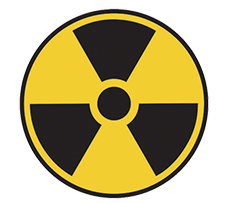Radiation safety awareness guidance for museum staff
Introduction
Prior to 1970, radium self-illuminating paint was applied to many military and civilian devices.
- caused the display faces of dials and gauges to “fluoresce” (glow in low light or in the dark)
- composed of a phosphorus base that glows when exposed to the energy emitted from the radioactive isotope radium-226
The main applications of Radium include:
- aircraft dials
- military vehicle gauges
- communications equipment
- compasses
Most devices no longer glow in the dark because the radioactive energy has degraded the paint’s fluorescent properties. However, they still remain radioactive.
There are currently thousands of these dials and gauges in Canada today.
- Many of them are found in Canadian Forces museums and historical collections
- Although NATO countries stopped using Radium in the 1960s, former Warsaw Pact (Soviet) countries continue to use equipment with Radium self-illuminating paint
Identifying self-illuminating artefacts
Though some donated artefacts are marked with the radiation warning symbol, there may be others that have not been screened for radium paint.
Without the proper survey equipment, it is impossible to definitively identify if radium is present. However, if a dial, gauge or compass is from a vehicle or aircraft that predates 1970, you can look for off-white or yellowish paint on the hands or face of the device.
Here are some artefacts that typically use radium paint:
- Avionic panel with Radium toggles, stenciling and dials
- Aircraft instrument panels
- Military magnetic compasses
- A damaged gauge from a Willis Jeep
Hazards
Under normal display conditions, there is minimal risk associated with these items. However, broken artefacts can release small paint fragments that:
- can come in contact with hands and clothing
- result in ingestion and inhalation of small particles of radioactive paint
These actions may cause health hazards.
Radium dials that are not damaged still emit small amounts of penetrating radiation similar to x-rays. While this is normally at low levels and is of minimal risk, personnel should limit the time they are in contact with these artefacts.
Handling artefacts containing radium
When handling artefacts with radium, follow these practices:
- wear disposable rubber or latex gloves
- wear a dust mask
- do not eat, drink or smoke
- minimize time spent with artefacts
- seal artefacts in clear plastic bags
- place radiation warning sign on bags (trefoil)
- store artefacts in a secure area away from staff or volunteers
- dispose of mask and gloves in normal garbage
- wash hands
Never touch suspected radioactive artefacts with your bare hands.
Broken dials or gauges
If you come across a broken dial or gauge:
- report it to your museum director; they will contact a qualified radiation safety officer who will dispose of the item
- do not touch the dial or attempt to clean it
- leave the area and wash hands immediately to ensure they are not contaminated
Disposing radium dials
If you need to dispose of radium dials, please contact your Radiation Safety Officer.
- do not throw dials into the garbage
- do not burn or incinerate anything radioactive, as this does not get rid of the radiation
Inquiries
